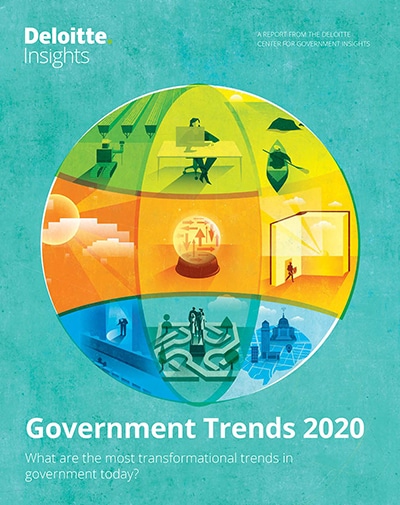
Cloud as innovation driver The foundation for employing emerging technologies in government
6 minute read
25 June 2019
 Joe Mariani United States
Joe Mariani United States Doug Bourgeois United States
Doug Bourgeois United States Jon Taillon United States
Jon Taillon United States Kerry Appleton-Norman United States
Kerry Appleton-Norman United States
Cloud computing was traditionally valued for the cost savings it enabled. Now government is increasingly looking at the greater value cloud can deliver—especially how it can enable future innovation.
For much of the past decade, cloud computing was seen as a less expensive way to store data and run applications. It has been an integral part of most digital transformations in both the private and public sectors. In 2010, then US federal CIO Vivek Kundra unveiled the “Cloud First” policy for federal agencies. The use of cloud in government has been increasing ever since, with federal cloud spending increasing 500 percent in the past eight years.1
Today, the focus on cloud is becoming even more pressing across the globe. In the United States, the National Association of State CIOs named cloud the No. 1 technology issue facing state CIOs, while the federal government announced a new “Cloud Smart” policy. Both Bahrain and the United Kingdom have adopted cloud-first policies to spur innovation, enhance agility, and improve services for citizens. 2
Why is such a mature platform receiving so much attention? Increasingly, the value proposition of cloud technologies is shifting from just cost savings to greater value. Cloud is the foundational setting for emerging technologies that governments are increasingly using such as AI, robotic process automation, the Internet of Things, and big data analytics.3 For example, 83 percent of enterprise AI is expected to be in the cloud by 2020.4 So while shifting to cloud may or may not reduce costs, investment in cloud can be justified by the greater value that it can deliver. Cloud can help break down data silos, drive AI adoption, and connect various stakeholders. In short, cloud can enable future innovations.
Breaking down data silos. Government often has data that goes underutilized due to siloed data sets. Breaking down these data silos can create new opportunities for innovation in many government domains: reducing congestion,5 anticipating crime,6 analyzing data on the fly for space experiments,7 and reducing fraud, waste, and abuse. 8 For example, transportation agencies in the state of Nevada deployed a cloud-based AI platform to gather data from connected cars, road cameras, road conditions, weather patterns, and apps such as Waze to predict high-risk corridors where accidents are likely to happen.9 Results of this pilot program include a 17 percent reduction in crashes along the highway,10 and, because the agencies were able to clear accident sites faster, a 23 percent reduction in secondary collisions.11

But cloud offers more than just a link to different sources of data. One of the key benefits of cloud is the flexibility it offers in setting up complex and innovative environments such as deep learning. That is why the Flemish Public Employment Service, VDAB, deployed a deep learning model to match candidates with job openings. The deep learning system can be considered an intelligent recommender system: It learns from the preferences of job seekers and employers. Embedding deep learning enables the department to take a very broad set of data into account and extend the data set. One of the advantages is that by retraining the model, it automatically takes into account the evolution in the job market. A potential drawback is of course bias in the data, a challenge the agency takes very seriously.12
Offering custom solutions to drive AI adoption. One area of cloud technology that is driving significant growth is Software-as-a-Service (SaaS).13 No longer does a government agency have to create its own solutions, when viable solutions are already on the cloud. The use of SaaS applications, where cognitive technologies are built into the software, has the potential to increase the uptake of AI and other emerging technologies in government.14
The US Department of Health and Human Services uses a cloud-based, AI-powered SaaS tool to help analyze grant applications. The tool can analyze data to identify patterns that can help predict the likely outcome of a grant, e.g., identifying applications with a high probability of a negative financial audit finding.15 The tool can also summarize hundreds of pages of information into a paragraph that agency analysts can quickly review and then decide whether or not to award a grant.16
Connecting stakeholders across the ecosystem. When it comes to innovation, connecting people is as important as connecting data. The heart of cloud’s ability to catalyze innovation is its ability to connect a wider ecosystem of partners that includes developers, designers, researchers, and other government agencies. In the past, these stakeholders may have created solutions that benefited just themselves. Now, housed in the cloud, those innovations can be available to all, and participants enjoy new opportunities for collaboration.
Take the example of Caltex Australia. As a fuel company, Caltex has thousands of employees spread out across the country in remote locations. An inability to share key information quickly with colleagues in different cities or divisions was slowing down work. The move to cloud-based productivity tools quickly allowed the sharing of key information, increasing productivity and reducing the need for in-person travel, which, in turn, reduced travel costs by one-third.17
Cloud can also connect players outside of a single organization. Organizations ranging from the FBI to the State of Delaware have found that cloud can connect them to a rich environment of external developers. This allows users to find existing solutions to their problems already developed on the cloud rather than having to build their own tools from scratch.18
Organizational changes for cloud
Unlocking cloud’s full potential can require significant organizational changes. For example, instead of directly developing and managing software, the IT organization becomes more of a trusted broker between business units and cloud solutions. This organizational transition can be a tremendous advantage because it ensures the entire organization adopts leading practices such as Agile and DevOps, but it can also pose significant challenges, often requiring an entire overhaul of an organization’s operating model.
The Australian federal government aims to use the cloud as a foundational platform to leverage emerging technologies such as AI, blockchain, and quantum computing. As part of the initiative, all Australian federal agencies will get access to cloud systems, applications, and software, helping them to automate processes and accelerate digital transformation.19
Government policies and investment dollars can help encourage cloud adoption. But ultimately, using the cloud for innovation requires a mindset shift in government: from solely measuring cost savings from cloud to developing innovative capabilities.
Data signals
- US$49.2 billion is the estimated value of the global government cloud market by 2023.20
- Sixty-two percent of US federal government respondents in a Deloitte survey reported that their organization had moved at least some applications to the cloud.21
- More than 50 percent of all software will be developed in or for the cloud by 2020.22
- The UK government is spending more than £1 billion each year to transition to cloud.23
Moving forward
- Introduce cloud-focused policies that go beyond location and vendor details to define and measure how all of the organization’s policies will help it better accomplish its mission.
- Break data silos by making data more organized, standardized, and accessible across the agency.
- Focus on innovation capabilities enabled by cloud, and work with your cloud vendor to gain access to the right types of tools and capabilities.
- Understand and define the spectrum of identity access management and ask questions such as “who owns what data?” and “who can access it?” for each application.
- Understand the organizational changes the shift to cloud might demand and make a deliberate change management plan.
Potential benefits
- Enable rapid testing of innovative ideas;
- Evolve a data-driven culture of collaborative decision-making; and
- Provide a platform to leverage emerging technologies.
Risk factors
- Obtaining funding for cloud migration;
- Growing cybersecurity concerns;
- Lack of strategy, governance structures, and standardized cloud procurement processes; and
- Conflicting state, federal, and international regulations on privacy, data use, security, and other issues.
Read more about how can cloud technology can enable innovation in government in Government cloud: A mission accelerator for future innovation.
© 2021. See Terms of Use for more information.
-
Smart government Article5 years ago
-
The rise of data and AI ethics Article5 years ago
-
The digital citizen Article5 years ago
-
AI-augmented government Article5 years ago
-
Anticipatory government Article5 years ago
-
Government Trends 2024 Article1 year ago















